Team:Berkeley/Project/Overview
From 2010.igem.org
| Line 15: | Line 15: | ||
This vesicle is then transported to choanoflagellate's food vacuole, where it merges with the vacuole. At this point the contents of the vesicle are exposed to the inside of the food vacuole and everything is destroyed, including the bacteria and all its contents. | This vesicle is then transported to choanoflagellate's food vacuole, where it merges with the vacuole. At this point the contents of the vesicle are exposed to the inside of the food vacuole and everything is destroyed, including the bacteria and all its contents. | ||
<br>[[Image:ChoanoDigestingBacteria.jpg]] <br> | <br>[[Image:ChoanoDigestingBacteria.jpg]] <br> | ||
| - | In order to avoid being digested by the choanoflagellate our bacteria must be able to deliver | + | In order to avoid being digested by the choanoflagellate our bacteria must be able to deliver the payload in the short time between ingestion and digestion. When the bacteria is in the phagocytotic vesicle, there exists two barriers between our payload and the cytoplasm of the choanoflagellate, the bacteria's own membranes, and the vesicle membrane itself. The bacteria's membranes are removed by the [https://2010.igem.org/Team:Berkeley/Project/Self_Lysis Self-Lysis] device, adapted from Berkeley's 2008 iGEM team. |
<br>[[Image:LysingBacteriaInChoano.jpg]] <br> | <br>[[Image:LysingBacteriaInChoano.jpg]] <br> | ||
| - | Lysis of the bacteria results in the release of the payload into the vesicle. At the same time the [https://2010.igem.org/Team:Berkeley/Project/Vesicle_Buster Vesicle-Buster] device, which is targeted to the periplasm of the bacteria is exposed to the vesicle membrane degrades | + | Lysis of the bacteria results in the release of the payload into the vesicle. At the same time the [https://2010.igem.org/Team:Berkeley/Project/Vesicle_Buster Vesicle-Buster] device, which is targeted to the periplasm of the bacteria, is exposed to the vesicle membrane degrades the vesicle. |
<br>[[Image:BustingVesicleInChoano.jpg]] <br> | <br>[[Image:BustingVesicleInChoano.jpg]] <br> | ||
<br> | <br> | ||
Revision as of 03:51, 25 October 2010
- Home
- Project
- Overview
- Motivation
- Other Organisms
- Parts
- Self-Lysis
- Vesicle-Buster
- Payload
- [http://partsregistry.org/cgi/partsdb/pgroup.cgi?pgroup=iGEM2010&group=Berkeley Parts Submitted]
- Results
- Judging
- Clotho
- Human Practices
- Team Resources
- Who We Are
- Notebooks:
- [http://www.openwetware.org/wiki/Berk2010-Daniela Daniela's Notebook]
- [http://www.openwetware.org/wiki/Berk2010-Christoph Christoph's Notebook]
- [http://www.openwetware.org/wiki/Berk2010-Amy Amy's Notebook]
- [http://www.openwetware.org/wiki/Berk2010-Tahoura Tahoura's Notebook]
- [http://www.openwetware.org/wiki/Berk2010-Conor Conor's Notebook]
We are engineering bacteria to serve as a vector to deliver payload into choanoflagellates. Since choanoflagellates naturally eat bacteria, our bacteria easily enters the choanoflagellate through phagocytosis. Once our bacteria is engulfed by the choanoflagellate, it is programmed to open itself using a self-lysis device derived from the 2008 UC Berkeley iGEM team. At this point, proteins being expressed by the bacteria will be released and ready to act. A vesicle buster device will open the small food vesicle and release our payload into the cytoplasm. The payload can consist of either protein, nucleic acids, or a combination of the both. We demonstrated the functionality of the the self-lysis and vesicle buster device by delivering GFP to the cytoplasm of the choanoflagellate. Future work involves targeting protein and DNA to the nucleus in order to genetically modify the choanoflagellate. A transposon/transposase device will move to the nucleus and splice DNA in or out of the genome. Although we tested our constructs on choanoflagellates, the devices are general enough to be applied to any phagocytic organism.
We start with a bacteria that expresses a payload.
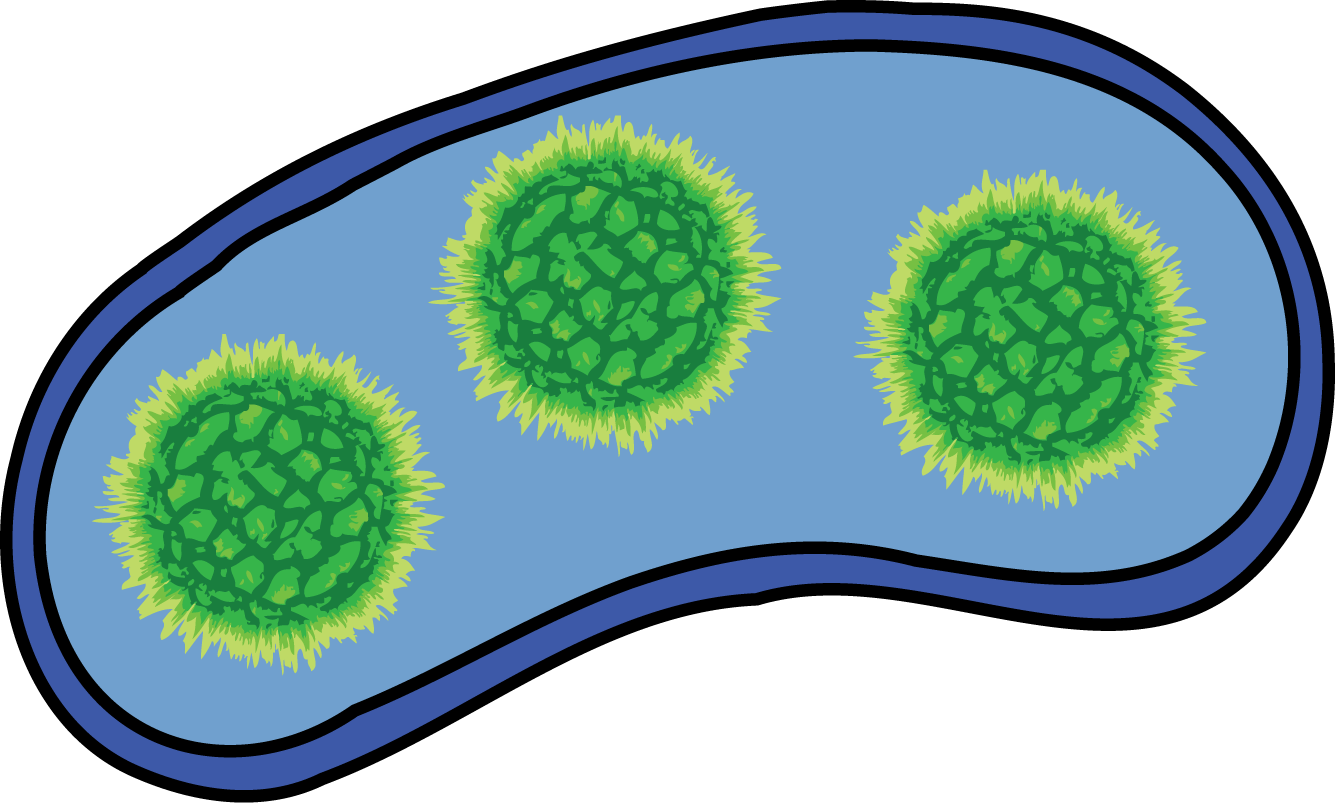
During normal digestion the choanoflagellate envelopes a bacterium in a phagocytotic vesicle.
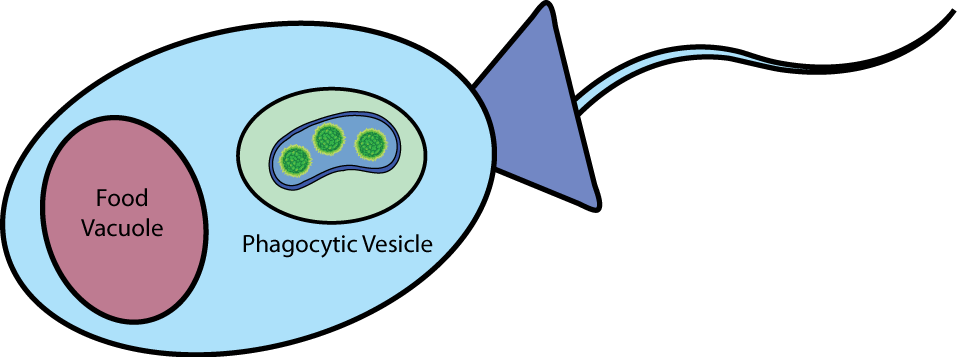
This vesicle is then transported to choanoflagellate's food vacuole, where it merges with the vacuole. At this point the contents of the vesicle are exposed to the inside of the food vacuole and everything is destroyed, including the bacteria and all its contents.
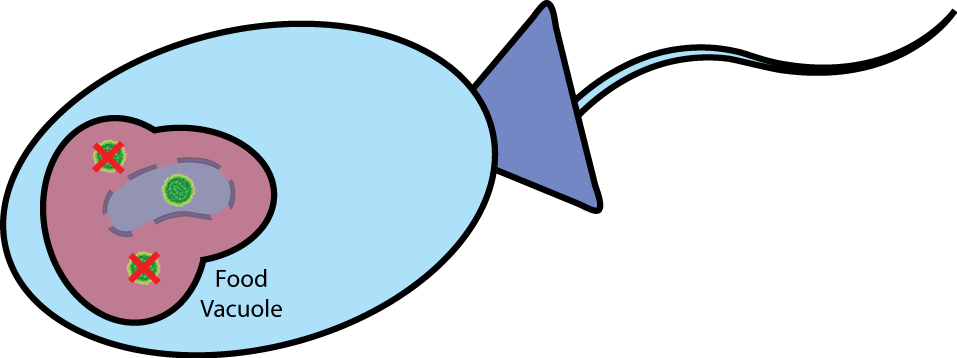
In order to avoid being digested by the choanoflagellate our bacteria must be able to deliver the payload in the short time between ingestion and digestion. When the bacteria is in the phagocytotic vesicle, there exists two barriers between our payload and the cytoplasm of the choanoflagellate, the bacteria's own membranes, and the vesicle membrane itself. The bacteria's membranes are removed by the Self-Lysis device, adapted from Berkeley's 2008 iGEM team.
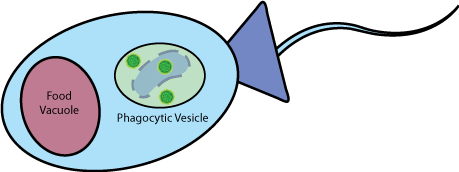
Lysis of the bacteria results in the release of the payload into the vesicle. At the same time the Vesicle-Buster device, which is targeted to the periplasm of the bacteria, is exposed to the vesicle membrane degrades the vesicle.
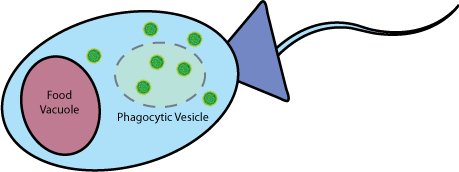
 "
"
